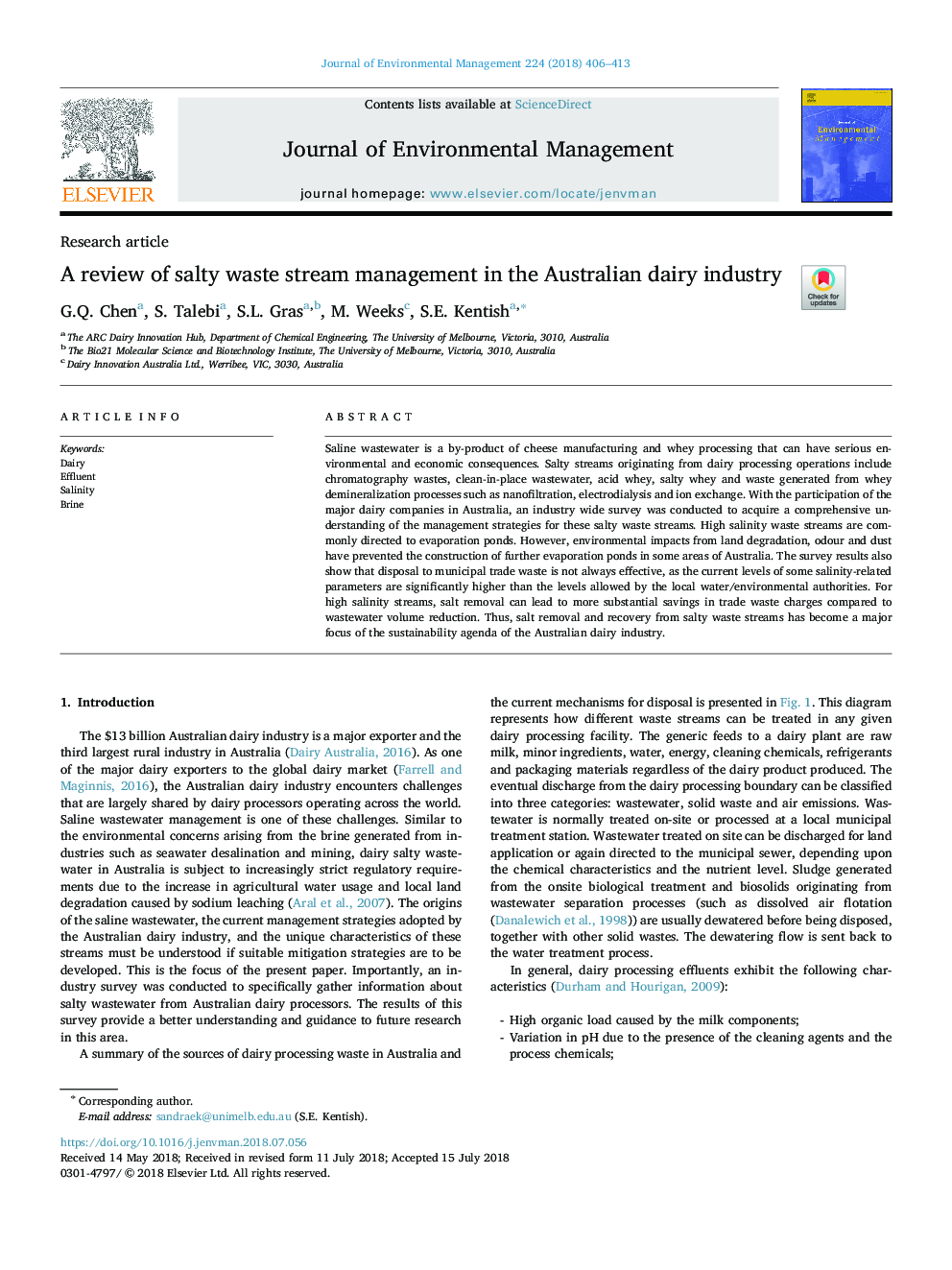| کد مقاله | کد نشریه | سال انتشار | مقاله انگلیسی | نسخه تمام متن |
|---|---|---|---|---|
| 7475724 | 1485194 | 2018 | 8 صفحه PDF | دانلود رایگان |
عنوان انگلیسی مقاله ISI
A review of salty waste stream management in the Australian dairy industry
ترجمه فارسی عنوان
بررسی جریان مدیریت زباله شور در صنعت لبنیات استرالیا
دانلود مقاله + سفارش ترجمه
دانلود مقاله ISI انگلیسی
رایگان برای ایرانیان
کلمات کلیدی
لبنیات، فاضلاب، شوری آبنمک،
ترجمه چکیده
فاضلاب سالین یک محصول جانبی تولید پنیر و پردازش آب پنیر است که می تواند پیامدهای جدی محیطی و اقتصادی داشته باشد. جریان های شور از عملیات پردازش لبنی شامل زباله های کروماتوگرافی، فاضلاب تمیز در محل، اسیدهای اسیدی، پنیر شور و زباله های تولید شده از فرایندهای دمیمرالیزاسیون پنیر مانند نانوفیلتراسیون، الکترودیلیز و مبادله یونی هستند. با مشارکت شرکت های بزرگ لبنیات در استرالیا، یک نظرسنجی گسترده صنعت به منظور درک جامع از استراتژی های مدیریت برای این جریان های پساب شور انجام شد. جریان های زائد شوری معمولا به حوضچه های تبخیری هدایت می شوند. با این حال، اثرات زیست محیطی از تخریب زمین، بویایی و گرد و غبار مانع ساختن استخرهای تبخیری بیشتر در برخی مناطق استرالیا شده است. نتایج این تحقیق همچنین نشان می دهد که دفع زباله های تجاری شهری همیشه موثر نیست، زیرا میزان فعلی برخی از پارامترهای مرتبط با شوریت به طور قابل توجهی بالاتر از سطوح مجاز مقامات آب و فاضلاب محلی است. برای شوری بالا، حذف نمک می تواند منجر به صرفه جویی قابل توجهی در هزینه های پسماندهای تجاری نسبت به کاهش حجم فاضلاب شود. بنابراین، حذف نمک و بازیابی پسماندهای سالم، تمرکز اصلی برنامه برنامه پایداری صنایع لبنی استرالیا است.
موضوعات مرتبط
مهندسی و علوم پایه
مهندسی انرژی
انرژی های تجدید پذیر، توسعه پایدار و محیط زیست
چکیده انگلیسی
Saline wastewater is a by-product of cheese manufacturing and whey processing that can have serious environmental and economic consequences. Salty streams originating from dairy processing operations include chromatography wastes, clean-in-place wastewater, acid whey, salty whey and waste generated from whey demineralization processes such as nanofiltration, electrodialysis and ion exchange. With the participation of the major dairy companies in Australia, an industry wide survey was conducted to acquire a comprehensive understanding of the management strategies for these salty waste streams. High salinity waste streams are commonly directed to evaporation ponds. However, environmental impacts from land degradation, odour and dust have prevented the construction of further evaporation ponds in some areas of Australia. The survey results also show that disposal to municipal trade waste is not always effective, as the current levels of some salinity-related parameters are significantly higher than the levels allowed by the local water/environmental authorities. For high salinity streams, salt removal can lead to more substantial savings in trade waste charges compared to wastewater volume reduction. Thus, salt removal and recovery from salty waste streams has become a major focus of the sustainability agenda of the Australian dairy industry.
ناشر
Database: Elsevier - ScienceDirect (ساینس دایرکت)
Journal: Journal of Environmental Management - Volume 224, 15 October 2018, Pages 406-413
Journal: Journal of Environmental Management - Volume 224, 15 October 2018, Pages 406-413
نویسندگان
G.Q. Chen, S. Talebi, S.L. Gras, M. Weeks, S.E. Kentish,
